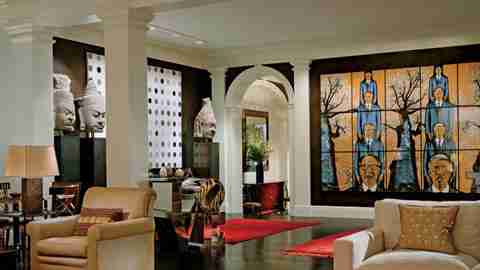Bold Gesture in New York
View Slideshow

Outside, the brick town house in the Upper East Side historic district of Manhattan is polite. Inside, angels may fear to tread. Within the pedigreed turn-of-the-last-century Georgian town house, the young owners and their children wanted the ambient spirit high. A master at mixing messages, Peter Marino created a fusion interior, combining old and new, serious and sassy. A hallucinogenic powder room with a psychedelic wallcovering is just the start of a five-story adventure studded with artistic surprises. The lacquered bronze pillow, Blood Solid , by Anish Kapoor warps space in its reflection at the foot of the staircase, and a rock-crystal chandelier outside the dining room, by French artist Robert Goossens, crosses the images of a crown with heart pendants. The artworks look at home in a setting that is itself an exercise in environmental art.
But for all the unexpected gestures, the clients and Marino—an architect who trained as a painter—worked with, rather than against, the house. "We wanted to keep much of its original wonder," says the wife. "What was once the playroom became the playroom again; same with the master bedroom. We didn't touch the staircase, and we pumiced the original marble floor and brought it back.
"Still," she continues, "we wanted young, something a little edgy—not with that older feel of upholstery and heavy curtains. Peter focused on how we live, on our taste, our collections and how the house would best showcase the art. Besides being a collector, he's a parent, and he steered us to how the children would live."
"Peteris very involved in surfaces, and he loves special textures that he either finds or designs himself."
"There's a very important aspect to all my work, now more than ever, and it's tying the interior design and architecture with the art," says Marino. "We didn't want to do an all-white space that looked like a generic downtown gallery transplanted uptown. We had to balance the contemporary art with rich finishes."
For all the swagger of an architect who worked with Andy Warhol in Manhattan's Studio 54 days, Marino is a master of the discreet background that integrates art into a larger, comfortable, organic whole. "Peter is very involved in surfaces, and he loves special textures that he either finds or designs himself," says the wife. "He brings in artists from all over the world."
"We're strong at surfaces," says the architect, admitting, "The interiors look dangerously like what I used to paint, a really mixed salad, not just greens but beets tossed in with everything else." Part of the expansive living room is covered in squares of parchment hand-painted an eggplant brown. "We painted each square in our studio," he says. The walls of the staircase—inspired by the coat of Siamese cats—are finished in Venetian plaster abraded to reveal layers of taupe and dark brown. Large slabs of veined Statuario marble on the walls and floor of the master bath resemble giant Rorschach tests.
The intriguing surfaces play down sweeping architectural changes. The spacious, open living room that effortlessly features a Sol LeWitt mural required major structural engineering and several months of construction. The floor of the big, warm-hearted kitchen had to be lowered to achieve its sense of generosity and welcome. Marino organized the spaces so that one flows graciously into another.
All along the way, Marino parses the rooms with surprises: "I like to throw in a jalapeño pepper now and then," he says. The imposing antique pedimented breakfront in the dining room was bought at auction because "I thought it looked like it came with the house." Marino himself designed handsome one-of-a-kind pieces, including dining room cabinets sheathed in python skin and a black-lacquered commode in the master bedroom, whose fluted columns and gilt-bronze frieze bring four centuries of decorative arts into the 21st century.
The inch-by-inch perfectionism required four years. "My husband and I spent unending hours in Peter's office, poring over every doorknob and hinge," the wife says. "Everything was done with love and care and intensity and creativity. We cried and we laughed. We felt we got a master's in architecture. Peter was an extraordinary mentor, and thanks to him, the house suits the way we live to a tee.
"People said it'd be the end of the marriage. Instead, it really consolidated our relationship. When we disagreed, we just took a vote."